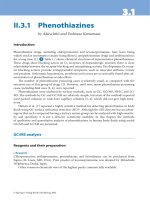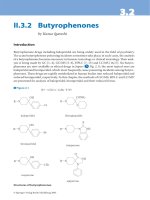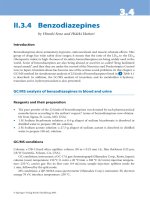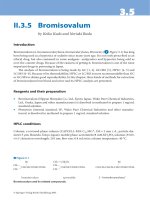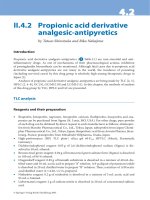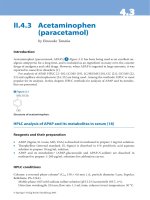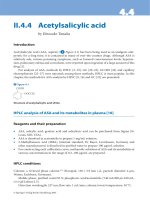Tài liệu Drugs and Poisons in Humans - A Handbook of Practical Analysis (Part 29) ppt
Bạn đang xem bản rút gọn của tài liệu. Xem và tải ngay bản đầy đủ của tài liệu tại đây (396.05 KB, 11 trang )
3.33.3
© Springer-Verlag Berlin Heidelberg 2005
II.3.3 Tricyclic and tetracyclic
antidepressants
by Akira Namera and Mikio Yashiki
Introduction
Many of antidepressants exert their e ects by inhibiting the reuptake of norepinephrine and
serotonin and by accerelating the release of them at synaptic terminals of neurons in the brain.
As characteristic structures of such drugs showing antidepressive e ects, many of them have
tricyclic or tetracyclic nuclei; this is the reason why they are called “ tricyclic antidepressants or
tetracyclic antidepressants”.
ere are many cases of suicides using the antidepressants; their massive intake sometimes
causes death. About 10 kinds of tricyclic and tetracyclic antidepressants are now being used
in Japan (
> Figure 3.1); among them, amitriptyline is best distributed [1, 2]. Recently, the use
of tetracyclic antidepressants is increasing, because of their mild side e ects and their high
e ectiveness with their small doses; the increase of their use is causing the increase of their
poisoning cases. Although carbamazepine does not belong to the antidepressant group, its
structure is very similar to those of tricyclic antidepressants; therefore, the drug is also in-
cluded in this chapter.
GC/MS analysis
Reagents and their preparation
• Amitriptyline, carbamazepine, clomipramine, desipramine, imipramine, maprotiline, mi-
anserin, nortriptyline and trimipramine can be purchased from Sigma (St. Louis, MO,
USA); pure powder of the following drugs was donated by each manufacturer: amoxapine
by Takeda Chem. Ind. Ltd., Osaka, Japan; dosulepin by Kaken Pharmaceutical Co., Ltd.,
Tokyo, Japan; lofepramine by Daiichi Pharmaceutical Co., Ltd., Tokyo, Japan; and setip-
tiline by Mochida Pharmaceutical Co., Ltd., Tokyo, Japan.
• A 20-g aliquot of sodium carbonate is dissolved in distilled water to prepare 100 mL solu-
tion (20 %, w/v).
• A 9.85-mL volume of hexane is mixed well with 0.15 mL isoamyl alcohol to prepare an
extraction solvent.
• A 1-mg aliquot of promethazine (Sigma) is dissolved in 10 mL acetonitrile to prepare inter-
nal standard solution (0.1 mg/mL).
272 Tricyclic and tetracyclic antidepressants
Structures of tricyclic and tetracyclic antidepressants and carbamazepine.
⊡ Figure 3.1
GC conditions
GC column: an HP-5MS fused silica capillary column (30 m × 0.25 mm i. d., lm thickness
0.25 µm, Agilent Technologies, Palo Alto, CA, USA).
GC/MS conditions; instrument: an HP 5890 Series II gas chromatograph (Agilent Tech-
nologies) connected with a mass spectrometer (HP-5971A MSD, Agilent Technologies); column
(oven) temperature: 170 °C (1 min) → 5 °C/min → 280 °C (4 min); injection temperature: 250 °C;
detection temperature: 280 °C; carrier gas: He (100 kPa); mass scan range: m/z 50–500.
273
Procedure
i. A 0.5-g (mL) aliquot of a specimen
a
, 0.5 mL dissolved water, 0.2 mL of 20 % sodium
carbonate solution and 25 µL of promethazine solution (0.1 mg/mL, IS
b
) are placed in a
10-mL volume glass centrifuge tube with a ground-in stopper and mixed well
c
.
ii. A 3-mL volume of hexane/isoamyl alcohol
d
(98.5:1.5, v/v) is added to the mixture and
shaken vigorously for 2 min.
iii. e tube is centrifuged at 3,000 rpm for 3 min.
iv. A 2.5-mL volume of the upper organic phase is transferred to a 8-mL volume glass vial and
evaporated to dryness under a stream of nitrogen.
v. e residue is dissolved in 0.5 mL hexane and a 1-µL aliquot of it is injected into
GC/MS.
Assessment of the method
> Figure 3.2 shows total ion chromatograms (TICs) obtained by GC/MS for tricyclic and
tetracyclic antidepressants (5 µg/mL) spiked into human whole blood. Using the slightly polar
capillary column (HP-5MS), the peak top of trimipramine could be separated from that of
imipramine, but they were not separated at the bottom completely. With non-polar columns,
many drugs could not be separated from each other; such a type of columns seems not suitable
for analysis of a specimen, which may contain multiple antidepressant drugs. e intermedi-
ately polar columns may be useful for drugs, which are not separable with non-polar or slightly
polar columns, but in these experiments, only the conditions using a slightly polar capillary
column are presented, because of its wide applicability to various drugs. Using the present TIC,
the detection limit was about 0.01 µg/g (mL); this means that toxic and fatal levels of the drugs
can be detected by this method.
Many of tricyclic antidepressants are demethylated and/or hydroxylated to be converted
into active metabolite(s)
e
. erefore, to assess a blood concentration of an antidepressant, the
combined concentration of the drug itself plus active metabolite(s) should be considered.
HPLC analysis
Reagents and their preparation
• Phosphoric acid used is of the special grade commercially available.
• An Oasis HLB
f
column (30 mg/cc, Waters, Milford, MA, USA) is activated by passing 1 mL
methanol and 1 mL distilled water.
• A 0.5-mL volume of methanol is mixed with 9.5 mL distilled water to prepare 5 % metha-
nol solution (v/v).
• A 2-g aliquot of phosphoric acid is dissolved in 1,000 mL of Milli Q water
g
; the pH of the
solution is adjusted to 3.0 by adding NaOH aqueous solution.
• A 1.22-g aliquot of sodium dihydrogenphosphate (dihydrate, NaH
2
PO
4
· 2H
2
O) and 1.73 g
disodium hydrogenphosphate are dissolved in 1,000 mL of Milli Q water; the pH of the
HPLC analysis
274 Tricyclic and tetracyclic antidepressants
⊡ Figure 3.2
TICs for tricyclic and tetracyclic antidepressants and carbamazepine obtained by GC/MS. A:
amitriptyline, B: mianserin, C: nortriptyline, D: imipramine, E: desipramine, F: promethazine (IS),
G: setiptiline, H: carbamazepine, I: maprotiline, J: clomipramine, K: amoxapine.
275
solution is adjusted to 6.5 by adding either NaOH aqueous solution or phosphoric acid to
prepare 20 mM phosphate bu er solution (pH 6.5).
• Mobile phase (A): 50 mL acetonitrile is well mixed with 450 mL of 0.2 % phosphoric acid.
A er degassing
h
, the solution is passed through a lter ( 0.45 µm) to be used as a mobile
phase.
• Mobile phase (B): 300 mL acetonitrile is well mixed with 200 mL of 20 mM phosphate buf-
fer solution (pH 6.5). A er degassing, the solution is passed through a lter (0.45 µm) to
be used as a mobile phase.
HPLC conditions
HPLC column
i
: an Eclipse XDB-C
8
octyl group bonded silica column (250 × 4.6 mm i. d., par-
ticle size 5 µm, Agilent Technologies).
HPLC conditions: an LC-10A high-performance liquid chromatograph (Simadzu Corp.,
Kyoto, Japan); detectors: a UV-VIS detector (UV-VIS, Shimadzu Corp.) and a photodiode
array detector (PDA, Shimadzu Corp.)
i. Conditions for acidic mobile phase (A)
Mobile phase: acetonitrile/phosphoric acid solution (0.2 %, pH 3.0) (1:9, v/v); column (oven)
temperature: 40 °C; ow rate: 1.0 mL/min; detection wavelength: 215 nm.
ii. Conditions for neutral mobile phase (B)
Mobile phase: acetonitrile/phosphate bu er solution (20 mM, pH 6.5) (6:4, v/v); other condi-
tions are the same as described above.
Procedure
i. A 0.5-g (mL) aliquot of a specimen is mixed with 10 µL phosphoric acid in a test tube and
mixed well.
ii. e mixture solution is poured into an activated Oasis HLB column
j
.
iii. e column is washed with 1 mL of 5 % methanol aqueous solution
k
.
iv. A target compound is eluted with 1 mL methanol into a glass vial; the eluate is evaporated
to dryness under a stream of nitrogen.
v. e residue is dissolved in 0.5 mL of each mobile phase; a 5-µL aliquot of it is injected into
HPLC for analysis.
Assessment of the method
> Figure 3.3 shows HPLC chromatograms for tricyclic and tetracyclic antidepressants (5 µg/
mL) spiked into human serum using the mobile phase (B). With the use of the Eclipse XDB-C
8
column, the peak top of nortriptyline (D) could be separated from that of amoxapine (E), but
major parts of their peaks could not be separated. When the acidic mobile phase (A) was used,
the 7 kinds of tricyclic antidepressants could be separated; but mianserin and setiptiline could
HPLC analysis
